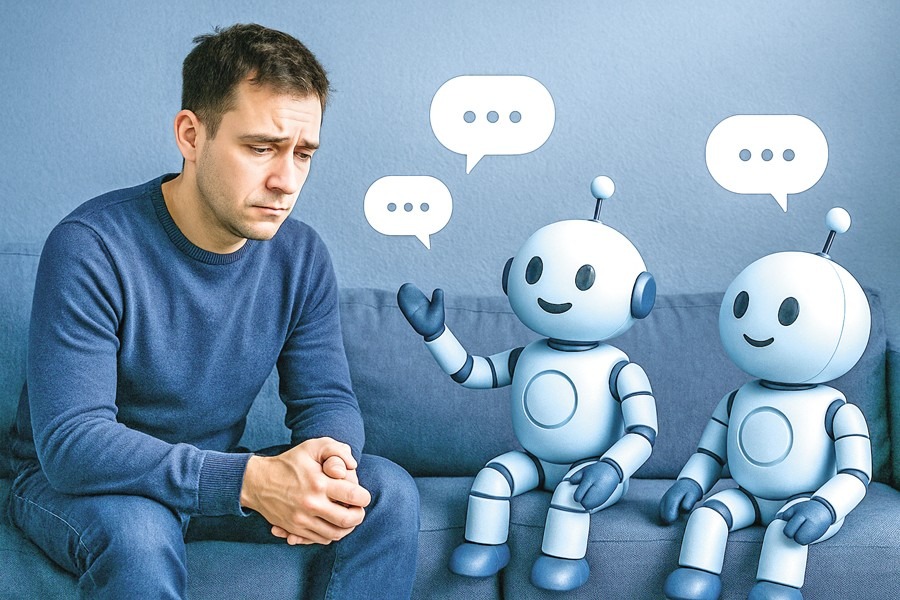
Published :
Updated :

The conversational AI chatbot, ChatGPT, can create texts like humans. So, writing of essays, reports, theses, answers to question in examinations at schools and colleges etc., are now being done by this AI tool. In other words, the machine is doing the job of thinking for us. In that case, shouldn't one be thankful that finally humans have been spared the strenuous task of cudgeling their brains to solve at least the problem of writing?
But the matter is not that simple. Concerned that to perform their schoolwork students are becoming dependent on generative AI tools, especially the Large Language Model (LLM), at an increasing rate, Nataliya Kosmyna, a research scientist at the MIT Media Lab, decided to find out how AI is leaving its impacts on the school students. To conduct the research, Kosmyna and her colleagues selected 54 subjects aged between 18 and 39 and divided them into three groups. The tasks assigned to the groups involved writing essays for tests called Scholastic Assessment Test (SAT). It is a kind of test widely used for college admissions in the USA. The first group was asked to write its answers with the help of ChatGPT, the second, the brain-only group, was to write just using their own brain power and the third, the Google Search group, took the help of Google search engine, to write its essays. How much the different groups engaged their brains to perform the tasks was measured by Electro encephalogram (EEG) test. Notably, EEG detects, measures and records brain's electrical signals representing its activity.
An interesting aspect of the brain function is the electrical activity it generates, which can be measured as brainwaves. These are produced when neurons (tiny brain cells) communicate with one another. The brainwaves occur at different frequencies and are classified into different categories based on their speed. The primary types of brainwaves, for instance, include alpha, beta, theta and delta. Alpha waves are produced when a person is awake but in a relaxed, meditative and restful state. The beta is faster than the alpha wave and shows up when one is thinking actively, concentrating, taking decision, or solving a problem. Theta wave occurs when one is in a creative and dreamy state. Delta waves, on the other hand, are the slowest and appear during deep sleep. They are important for physical healing, growth and immune function.
Now, Kosmyna's three groups performing their tasks produced three distinct results. The ChatGPT users showed the lowest brain engagement and consistently underperformed at the neural, linguistic and behavioural levels. Over the months, they even got lazier with their assignments and often resorted to copying and pasting. Actually, the ChatGPT users all wrote very similar essays devoid of original thought. Two English teachers who assessed the write-ups termed those 'soulless'.
That means dependence on the particular type of generative AI of the Large Language Models (LLMs) category that create and process texts can harm learning, particularly of young users.
The brain-only group, on the other hand, showed the highest neural connectivity, especially in the alpha, theta and delta bands, which are connected with creativity, formation of ideas, the amount of information one can process in any given time (memory load) and the cognitive process of understanding the meaning of language (semantic processing). Kosmyna and her research team found that unlike the ChatGPT users, the brain-only group was not detached from their task but more engaged, owned their work and was satisfied with their write-ups.
The third, or the Google Search group, proved to be more brain-engaged than the ChatGPT users, owned its work and expressed satisfaction about its performance.
But when asked to rewrite one of their essays, the ChatGPT users had practically no memory of their previous work with weaker alpha and theta brainwaves. The other two groups did well in this regard.
Kosmyna believes a young learner's brain should be allowed to develop more naturally in an analog way.
sfalim.ds@gmail.com


 For all latest news, follow The Financial Express Google News channel.
For all latest news, follow The Financial Express Google News channel.